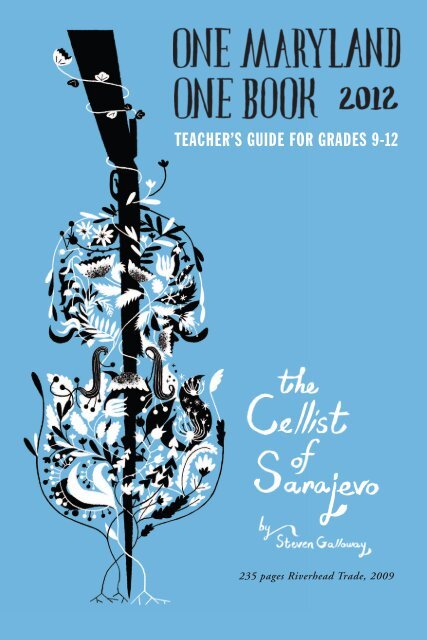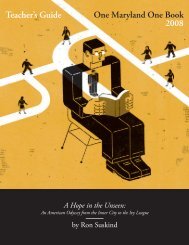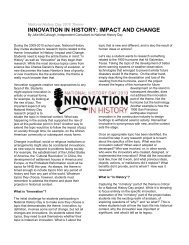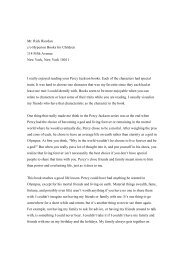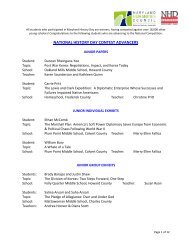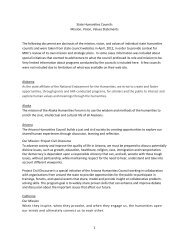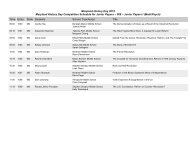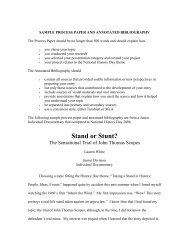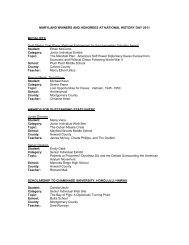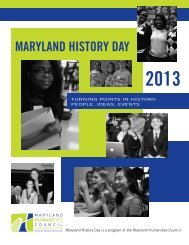Teacher's Guide for Grades 9-12 - Maryland Humanities Council
Teacher's Guide for Grades 9-12 - Maryland Humanities Council
Teacher's Guide for Grades 9-12 - Maryland Humanities Council
Create successful ePaper yourself
Turn your PDF publications into a flip-book with our unique Google optimized e-Paper software.
Teacher’s <strong>Guide</strong> <strong>for</strong> <strong>Grades</strong> 9-<strong>12</strong><br />
235 pages Riverhead Trade, 2009
WHAT NEW THINGS WOULD WE HAVE TO<br />
TALK ABOUT WITH ONE ANOTHER?<br />
Celebrating its fifth year, One <strong>Maryland</strong><br />
One Book is <strong>Maryland</strong>’s only statewide<br />
community reading program. It is designed to<br />
bring together diverse people in communities<br />
across the state through a shared experience:<br />
the reading and thoughtful discussion of the<br />
same book. Each year, the book selection<br />
process is guided by a common theme, which<br />
this year is “courage and unity in times of<br />
war.” The <strong>Maryland</strong> Center <strong>for</strong> the Book at<br />
the <strong>Maryland</strong> <strong>Humanities</strong> <strong>Council</strong> partners<br />
with public libraries, high schools, colleges<br />
and universities, museums, bookstores,<br />
correctional facilities and other organizations<br />
to bring book-centered discussions and other<br />
related programs to communities across<br />
<strong>Maryland</strong>.<br />
The <strong>Maryland</strong> <strong>Humanities</strong> <strong>Council</strong> has at the<br />
core of its mission the deep commitment to<br />
providing <strong>Maryland</strong>ers with an opportunity<br />
to gather and discuss issues important to<br />
their lives and communities, believing that a<br />
great work of literature provides an excellent<br />
springboard to do so. One <strong>Maryland</strong> One<br />
Book is not just about reading or literature.<br />
It is also about bringing people together <strong>for</strong><br />
meaningful dialogue.<br />
The book selected <strong>for</strong> 20<strong>12</strong> is The Cellist of<br />
Sarajevo by Steven Galloway.<br />
Join In<br />
We invite you to join Honorary Chairperson,<br />
<strong>Maryland</strong>’s First Lady Katie O’Malley, and<br />
thousands of other <strong>Maryland</strong>ers at one of the<br />
many book discussions and related programs<br />
happening around the state in September and<br />
October.<br />
If you’re out and about, you might find<br />
copies of The Cellist of Sarajevo in unexpected<br />
places. Our Wandering Books can be found<br />
in public spaces such as parks, buses, malls,<br />
county fairs and doctor’s offices. If you find a<br />
copy, it’s yours <strong>for</strong> a short time. Register the<br />
book online so we can see how far it travels<br />
(instructions are included with the book),<br />
read it, review it, and release it <strong>for</strong> someone<br />
else to enjoy.<br />
To find One <strong>Maryland</strong> One Book programs in<br />
your area, go to www.onemarylandonebook.org<br />
and click on the Calendar.<br />
For all the latest in<strong>for</strong>mation, “Like” or follow us:<br />
facebook.com/One<strong>Maryland</strong>OneBook<br />
@MD<strong>Humanities</strong><br />
Look <strong>for</strong> Steven Galloway at the Baltimore Book<br />
Festival on Sunday, September 30 and other<br />
venues around the state during the first week<br />
of October.<br />
Get the Book<br />
Pick up a copy of The Cellist of Sarajevo at your<br />
local public library or bookstore and start<br />
up a conversation with your family, friends,<br />
coworkers, or even the person sitting next to<br />
you as you ride the bus or train. This is your<br />
chance to take a moment to have a great<br />
conversation with an old friend or to make a<br />
new one.<br />
Check out author Steven Galloway as<br />
he talks about The Cellist of Sarajevo.
LETTER FROM HONORARY CHAIRPERSON<br />
MARYLAND’S FIRST LADY KATIE O’MALLEY<br />
Thank you <strong>for</strong> joining me and the <strong>Maryland</strong> <strong>Humanities</strong> <strong>Council</strong> <strong>for</strong> the fifth anniversary of One<br />
<strong>Maryland</strong> One Book, our state’s community reading project. Since its inception in 2008, nearly<br />
23,000 people have attended over 700 programs and many more have read the annually-selected<br />
books. This year, you will be one of thousands who make time to take part in this shared experience.<br />
As <strong>Maryland</strong> celebrates historical milestones, including the bicentennial of the War of 18<strong>12</strong> and<br />
the 150th anniversary of the Civil War, we can reflect on our history by discussing a contemporary<br />
war. The selection of Steven Galloway’s The Cellist of Sarajevo offers a personal glimpse, though<br />
fictionalized, into the horrors, struggles, and resiliency caused by violence and inhumanity. Haunting<br />
and serious, this wonderful work of literature offers hope—hope <strong>for</strong> each of us as individuals and<br />
hope <strong>for</strong> the choices we make and how they can uplift rather than destroy.<br />
A program of the <strong>Maryland</strong> <strong>Humanities</strong> <strong>Council</strong>’s <strong>Maryland</strong> Center <strong>for</strong> the Book, One <strong>Maryland</strong><br />
One Book is made possible through the generosity of our sponsors and community partners, many<br />
of which have supported the program since its launch. We greatly thank them <strong>for</strong> their support. We<br />
encourage you to pick up a copy of The Cellist of Sarajevo and join the conversation. Find out how<br />
to get involved at www.onemarylandonebook.org.<br />
Sincerely,<br />
Katie O’Malley<br />
First Lady of <strong>Maryland</strong><br />
1
About the Author<br />
Steven Galloway was born in Vancouver and raised in<br />
Kamloops, British Columbia. Published in 2008, The<br />
Cellist of Sarajevo has become an international bestseller<br />
with rights sold in 20 countries. It has been called<br />
“inspiring” by Entertainment Weekly, “un<strong>for</strong>gettable” by<br />
the Los Angeles Times, and “an exquisite novel of war and<br />
loss, music and solace” by O, The Oprah Magazine.<br />
Khaled Hosseini, author of The Kite Runner and A Thousand<br />
Splendid Suns, has said, “This gripping novel transcends<br />
time and place. It is a universal story, and a testimony to<br />
the struggle to find meaning, grace, and humanity, even<br />
amid the most unimaginable horrors.”Galloway teaches<br />
creative writing at the University of British Columbia.<br />
About the Book<br />
In a city under siege, four people whose lives have been upended are ultimately reminded of what it is to<br />
be human. From his window, a musician sees 22 of his friends and neighbors killed by a mortar attack.<br />
In an act of defiance, the man picks up his cello and decides to play at the site of the attack <strong>for</strong> 22 days<br />
in their memory. Elsewhere, a young man leaves home to collect drinking water <strong>for</strong> his family and in the<br />
face of danger must weigh the value of generosity against selfish survivalism. A third man, older, sets off<br />
in search of bread and distraction and instead runs into a long-ago friend who reminds him of the city<br />
he thought he had lost, and the man he once was. As both men are drawn into the orbit of cello music,<br />
a fourth character—a young woman, a sniper—holds the fate<br />
of the cellist in her hands. While she protects him with her life,<br />
her own army prepares to challenge the kind of person she has<br />
become.<br />
A novel of great intensity and power, The Cellist of Sarajevo<br />
brilliantly explores how war can change one’s definition of<br />
humanity, how music affects our emotional endurance, and how<br />
a romance with the rituals of daily life can itself be a <strong>for</strong>m of<br />
resistance.
ABOUT THE SIEGE OF SARAJEVO<br />
The Siege of Sarajevo began twenty years ago, in April 1992, and lasted until February<br />
1996—the longest siege of any capital city in the history of modern warfare. Sarajevo, now<br />
capital of the independent nation of Bosnia and Herzegovina, has been a cultural, religious,<br />
and commercial hub of the Balkans since the 15th Century. The siege was part of the Yugoslav<br />
Wars—a series of complex ethnic conflicts fought between 1991 and 1995 following the<br />
disintegration of Yugoslavia. The siege broke out when the European Community (now the<br />
European Union or EU) recognized Bosnia’s independence. An estimated 18,000 Serb rebels,<br />
led by Radovan Karadžić and Ratko Mladić, began bombarding Sarajevo with sniper shots and<br />
shellfire from the hills surrounding the city. Their goal was to create a new Serbian state,<br />
Republika Srpska.<br />
Prior to the conflict, the city was a cosmopolitan center of 525,980 inhabitants that<br />
was approximately 50% Muslim, 30% Serb, 10% Yugoslav, 7% Croat and 3.5% Jewish.<br />
According to a report <strong>for</strong> the United Nations Commission of Experts, nearly 10,000 persons<br />
were killed or went missing during the siege, including over 1,500 children. An additional<br />
56,000 persons were wounded, including nearly 15,000 children. An average of 329 shell<br />
impacts hit the city each day, causing extensive damage to both civilian and cultural property;<br />
the <strong>Council</strong> of Europe’s Committee on Culture and Education concluded that most<br />
of the buildings in the city had been damaged to a greater or lesser degree. UNICEF<br />
reported that of the estimated 65,000 to 80,000 children in the city, at least 40% had been<br />
directly shot at by snipers; 51% had seen someone killed; 39% had seen one or more family<br />
members killed; 19% had witnessed a massacre; 48% had their home occupied by someone<br />
else; 73% had their home attacked or shelled; and 89% had lived in underground shelters.<br />
The area has since stabilized, but the effects of the siege will no doubt be felt <strong>for</strong> generations.<br />
Sources:<br />
• Bassiouni, M. Cherif, ed. Study of the battle and siege of Sarajevo, Final report of the United Nations<br />
Commission of Experts. Bristol, UK: University of the West of England, http://www.ess.uwe.ac.uk/comexpert/<br />
ANX/VI-01.htm<br />
• “Chronology: What happened during the war in Bosnia?” Reuters 21 July 2008.<br />
http://www.reuters.com/article/2008/07/21/idUSL21644464<br />
• Richards, Rogers. “Remember Sarajevo.” Digital Journalist, December 2003.<br />
http://digitaljournalist.org/issue0405/remember_sarajevo.pdf<br />
• Sarajevo Under Siege, 1992-1996. http://www.sa92.ba/v1/index.php<br />
3
<strong>Maryland</strong> State Department of Education Core Learning Goals - English<br />
GOAL 1: READING, REVIEWING AND RESPONDING TO TEXT<br />
The student will demonstrate the ability to respond to a text by employing personal experiences and<br />
critical analysis.<br />
EXPECTATION 1.1 The student will use effective strategies be<strong>for</strong>e, during, and after reading, viewing,<br />
and listening to self-selected and assigned materials.<br />
INDICATOR 1.1.1 The student will use pre-reading strategies appropriate to both the text and<br />
purpose <strong>for</strong> reading by surveying the text, accessing prior knowledge, <strong>for</strong>mulating questions,<br />
setting purpose(s), and making predictions.<br />
INDICATOR 1.1.2 The student will use during-reading strategies appropriate to both the text<br />
and purpose <strong>for</strong> reading by visualizing, making connections, and using fix-up strategies such as<br />
re-reading, questioning, and summarizing.<br />
INDICATOR 1.1.3 The student will use after-reading strategies appropriate to both the text and<br />
purpose <strong>for</strong> reading by summarizing, comparing, contrasting, synthesizing, drawing<br />
conclusions, and validating the purpose <strong>for</strong> reading.<br />
EXPECTATION 1.2 The student will construct, examine, and extend meaning of traditional and<br />
contemporary works recognized as having significant literary merit.<br />
INDICATOR 1.2.1 The student will consider the contributions of plot, character, setting, conflict,<br />
and point of view when constructing the meaning of a text.<br />
INDICATOR 1.2.2 The student will determine how the speaker, organization, sentence structure,<br />
word choice, rhythm, and imagery reveal an author’s purpose.<br />
INDICATOR 1.2.3 The student will explain the effectiveness of stylistic elements in a text that<br />
communicate an author’s purpose.<br />
INDICATOR 1.2.5 The student will extend or further develop meaning by explaining the<br />
implications of the text <strong>for</strong> the reader or contemporary society.<br />
EXPECTATION 1.3 The student will explain and give evidence to support perceptions about print<br />
and non-print works.<br />
INDICATOR 1.3.1 The student will explain how language and textual devices create meaning.<br />
INDICATOR 1.3.5 The student will explain how common and universal experiences serve as the<br />
source of literary themes that cross time and cultures.
BEFORE READING:<br />
Students read silently the first four paragraphs of the Afterward to gain insight into Sarajevo’s 1992-<br />
1996 conflict.<br />
Setting:<br />
Sarajevo, Bosnia<br />
• Map of Sarajevo and the surrounding region:<br />
http://wikitravel.org/en/Image:Balkans_regions_map.png<br />
• Terrain map Sarajevo:<br />
http://pda.medjugorje.ws/en/apparitions/docs-medjugorje-map-bosniaherzegovina/<br />
- ch1<br />
NOTE: Mountains surrounding Sarajevo<br />
• Brief History Bosnia-Herzegovina:<br />
http://www.kakarigi.net/manu/briefhis.htm<br />
History is not as important as the population breakdown.<br />
• ABC News video: June 10, 1992 Sarajevo Under Siege:<br />
http://abcnews.go.com/Archives/video/bosnia-war-sarajevo-siege-1992-9866571<br />
• “The Siege of Sarajevo” 1992-1996:<br />
http://www.thenagain.info/webchron/easteurope/SarajevoSiege.CP.html<br />
Handout Prologue/Book One Vocabulary list (At end of guide)<br />
Allow time <strong>for</strong> students to find the sentences in the book using the vocabulary words and page<br />
numbers. Students use the sentence content to determine the meaning, sometimes reading the<br />
entire paragraph if necessary. Next students compare answers with a partner. If there is confusion,<br />
students can use web or print dictionaries.<br />
DURING READING<br />
• Students fill in character study graphic organizer. (Provided at end of guide)<br />
• Students discuss and debate notable passages and situations. (Many questions provided per<br />
section.)<br />
• Share: Audio: Cellist playing Albinoni’s Adagio in G Minor with reading of the novel’s Prologue;<br />
students follow along. http://www.naxosaudiobooks.com/6333<strong>12</strong>.htm<br />
5
CHARACTERS<br />
• The Cellist - Formerly the principal cellist in the Sarajevo Symphony Orchestra; plays in the<br />
street each day <strong>for</strong> 22 days in honor of 22 people killed while waiting <strong>for</strong> bread<br />
• Arrow - 30-year-old sniper; works to protect the city from other snipers in the surrounding hills;<br />
assigned to protect the cellist while he plays<br />
• Nermin Filipovic - Professional soldier; Arrow’s unit commander<br />
• Kenan - 40-year-old father of three; clerical assistant in an accounting firm; navigates the<br />
dangerous streets to get water <strong>for</strong> his family<br />
• Amilia - Kenan’s wife; 37 years old but looks over 50 years old<br />
• Mrs. Ristovski - Kenan and Amilia’s elderly neighbor<br />
• Dragan - 64-year-old man; stayed in Sarajevo but sent son and wife to safety in Italy;<br />
works in a bakery<br />
• Raza - Dragan’s wife<br />
• Davor - Dragan and Raza’a 18-year-old son<br />
• Emina - Raza’s friend<br />
GENRE: Historical fiction<br />
THEMES: War, hatred, revenge, survival, perseverance, autonomy, morals, hope<br />
TONE: Fearful, anxious, oppressive, overwhelming, monochromatic, nostalgic, hopeful<br />
WRITING STYLE: 3rd person narrative<br />
ASSIGNMENT #1 (PROLOGUE – PAGES xvi-xix)<br />
VOCABULARY:<br />
• The Cellist dwindles (v. page xvi) inviolable (adj. page xvi)<br />
DISCUSSION QUESTIONS:<br />
The Cellist (pages xv-xix)<br />
1 Writing is a journey of choices. Every author chooses specific words, specific sentence structure,<br />
specific phrasing. Characters, storyline, high points, and resolutions are planned, revised, and<br />
recreated throughout the writing process. Everything within a novel is intentional. With this in<br />
mind, why might the prologue end with the same words with which it starts?<br />
2 Throughout the book, Steven Galloway repeats passages. What impact does it have on the story<br />
and on the reader?
ASSIGNMENT #2 (BOOK ONE – PAGES 3-33)<br />
VOCABULARY:<br />
• Arrow velocity (n. page 4) detritus (n. page 4)<br />
impunity (n. page 6) repercussions (n. page 7)<br />
depredated (adj. page 7) pulping (v. page 9)<br />
• Kenan ferocity (n. page 19) corrugated (adj. page 20)<br />
escalating (gerund page 20)<br />
• Dragan conscripts (n. page 26) hover (v. page 29)<br />
DISCUSSION QUESTIONS:<br />
Arrow (pages 3-<strong>12</strong>)<br />
1 In what ways does Arrow feel that she’s different from the soldiers on the hill?<br />
2 Reread the last sentence on page 9. How does the vivid description affect you as a reader?<br />
Kenan (pagse 13-22)<br />
1 Compare and contrast Arrow and Kenan.<br />
2 What has Kenan learned is necessary <strong>for</strong> him to survive his daily life? Be specific.<br />
3 What purpose might Galloway see <strong>for</strong> the character of Mrs. Ristovski?<br />
Dragan (pages 23-33)<br />
1 Describe Sarajevo prior to the men on the hill.<br />
2 How has Dragan’s view of Sarajevo changed? Why do you think it has? Is it simply because<br />
buildings and people have been destroyed? Is his present view necessary <strong>for</strong> his survival?<br />
3 Reread the paragraph that starts on the bottom of page 30. What is the descriptive simile? If<br />
you’ve seen a flopping fish gasping <strong>for</strong> air, describe it. Does using that specific simile help you<br />
understand one process of dying? Has anyone watched anything die in real life? If the topic is not<br />
too sensitive, describe what you saw.<br />
Note: Students should continue to add to the Character Study graphic organizers throughout the reading.<br />
ASSIGNMENT #3 (BOOK TWO – pages 37-152)<br />
VOCABULARY:<br />
• Kenan cupola (n. page 43) demarcation (n. page 48)<br />
nuance (n. page 48) benign (adj. page 56)<br />
malevolent (adj. page 56) parameters (n. page 59)<br />
• Dragan roulette (n. page 79) mercenaries (n. page 84)<br />
• Arrow peripheral (adj. page 93)<br />
7
• Kenan incendiary (adj. page 97) ducats (n. page 103)<br />
paraphernalia (n. page 106)<br />
• Dragan benevolence (n. page 1<strong>12</strong>)<br />
• Kenan eviscerated (v. page 145) impunity (n. page 145)<br />
DISCUSSION QUESTIONS:<br />
Kenan (pages 37-54)<br />
1 What are the benefits and challenges of having a friend like Ismet, who’s a soldier?<br />
2 Explain Kenan’s attitude toward death, the army, and soldiers.<br />
3 What do the details about Kenan’s trips to get water tell us about war?<br />
4 What is your most valued possession? Would you pay 20 times the price to have it?<br />
5 Explain the comparison between Kenan and a pigeon.<br />
Arrow (pages 55-64)<br />
1 “Shoot or be shot.” Is that the only way to survive war?<br />
2 How does Arrow’s supervisor, Nermin, justify killing men on the hill so Arrow doesn’t feel as bad<br />
about killing people?<br />
3 Arrow sometimes gets lost in her thoughts. What brings her back? (shelling, bombing, etc.)<br />
Explain why that is an example of irony.<br />
Dragan (pages 65-79)<br />
1 Identify the ways life has changed in Sarajevo by reading passages that answer the question.<br />
2 What is Sarajevo roulette? How does one know when to play?<br />
Arrow (pages 80-96)<br />
1 At the top of page 83, read aloud and discuss the passage that equates Arrow to a weapon.<br />
2 What does Arrow consider when choosing a post <strong>for</strong> herself?<br />
3 What is the benefit of knowing Arrow’s thoughts? Why would Galloway choose to provide so<br />
many details? (slows down the action and personifies minute-by-minute survival)<br />
4 Describe the projections that answer Arrow’s question, “Why didn’t he shoot?”.<br />
Kenan (pages 97-106)<br />
1 Be<strong>for</strong>e reading this section, consider the following: if a bridge was covered by snipers and you<br />
must get from one end to the other, how would you do so to make it difficult <strong>for</strong> a sniper to hit<br />
you?<br />
2 Kenan identifies the library in Sarajevo as a symbol of the city. What could be a symbol of your<br />
city, community, or county? Justify.<br />
Dragan (pages 106-119)<br />
1 Be<strong>for</strong>e reading this section, discuss whether you think it’s worse to be wounded or killed.<br />
2 Where is the wonderfully descriptive simile on page 106? Why is it fitting?<br />
3 What might the value be of “doing the things they know how to do” during such a traumatic<br />
time? Might it aid survival? Debate.<br />
4 Compare and contrast Dragan and the dog that Galloway chose to include.<br />
Arrow (pages <strong>12</strong>1-136)<br />
1 Is Galloway’s choice to vary each character’s voice helpful or difficult to follow? Explain.<br />
2 Why include humor in the midst of so much tragedy (page <strong>12</strong>4)?
3 Compare and contrast Arrow and the men on the hill.<br />
4 War is more than conflict between two sets of people. Discuss the conflict that all three characters<br />
endure.<br />
Kenan (pages 137-152)<br />
1 If time allows, fill up six one-liter bottles and tie them together in two groups of three with rope<br />
long enough to drape across a student’s neck. Provide two larger filled bottles (perhaps twoliter<br />
bottles) and ask student(s) to experience what Kenan did when carrying filled bottles a<br />
great distance.<br />
2 Explain the irony located at the bottom of page141. (Foot blown off; shoe undamaged)<br />
3 Read aloud the vividly descriptive section on page 141 beginning with, “Kenan has heard it<br />
said…” to page 146, “…taking one last look at the place where they died.” Discuss the chaos and<br />
horrors of war.<br />
ASSIGNMENT #4 (BOOK THREE – PAGES 155-213)<br />
VOCABULARY:<br />
• Arrow volition (n. page 170)<br />
• Kenan languid (adj. page 184) maudlin (adj. page 186)<br />
beholden (adj. page 189) relent (v. page 191)<br />
• Arrow defer (v. page 199)<br />
• Dragan maw (n. page 210) binary (adj. page 211)<br />
DISCUSSION QUESTIONS:<br />
Dragan (pages 155-164)<br />
1 Is Dragan a coward as he believes? Explain your answer and be able to defend if questioned.<br />
2 Read page 164 aloud. What provides hope <strong>for</strong> Dragan?<br />
Arrow (pages 165-180)<br />
1 Is Arrow as bad as the men on the hill? Explain.<br />
2 Is killing another human being ever okay? Debate.<br />
3 The Colonel said, “There is us, and there is them.” Do you agree that war is either black or white?<br />
4 What consequences might Arrow face as a result of her actions in the war?<br />
Kenan (pages 181-193)<br />
1 While listening to the cellist, Kenan has an epiphany. What does he conclude about the cellist’s<br />
playing?<br />
2 What does Kenan mean when he says, “There are dead among the living”?<br />
3 What makes Kenan hopeful?<br />
Arrow (pages 194-213)<br />
1 Arrow is adamant that she won’t kill a civilian even when Hasan points out that the civilians are<br />
relatives of the men on the hills. Why might that not be enough <strong>for</strong> Arrow to change her mind?<br />
2 Who’s the enemy? The people in the city or the men on the hills?<br />
9
ASSIGNMENT #5 (BOOK FOUR – PAGES 218-231)<br />
VOCABULARY:<br />
• Arrow lament (n. page 228) reviled (v. page 229)<br />
DISCUSSION QUESTIONS:<br />
Kenan (pages 217-221)<br />
1 How has Kenan changed since the beginning of the book? Or do you just know more about him<br />
now? Justify your answer.<br />
Dragan (pages 222-225)<br />
1 Starting at the bottom of page 222, read aloud to the end of that paragraph on page 223. How<br />
has Dragan changed since the beginning of the book? Do you think it will make a difference?<br />
Arrow (pages 226-231)<br />
1 Did the cellist’s playing <strong>for</strong> 22 days make a difference <strong>for</strong> others or did it just appease his soul?<br />
2 Why would Galloway choose to have Arrow reveal her name be<strong>for</strong>e she was killed?<br />
3 Arrow started Book One and was the last character to be shared at the end of Book Four. Any<br />
ideas why?<br />
4 Return to page 80 and find an example of <strong>for</strong>eshadowing. Did anyone catch these examples while<br />
reading? What else led you to believe that Arrow would be killed?<br />
AFTER READING<br />
• Students listen to NPR “Two Decades After Siege, Sarajevo Still a City Divided.”<br />
http://www.npr.org/20<strong>12</strong>/04/05/150009152/two-decades-after-siege-sarajevo-still-a-citydivided<br />
• Student Essay - With a partner brainstorm the following: Death comes in many <strong>for</strong>ms. Discuss<br />
the multiple <strong>for</strong>ms of death that the people in Sarajevo experienced. Be specific and support with<br />
examples. Students individually write an essay on the above topic.<br />
• Using the character graphic organizer, with a partner or alone, students fill in a three circle Venn<br />
diagram, comparing the three main characters. (Diagram included at the end)
SUGGESTED ENRICHMENT<br />
1 The cover of this book is fairly nondescript. Using the web and resources cited in this guide, have<br />
students work in pairs or a triad to create a new front and back cover, an inside summary, and<br />
a back inside biography about the author Steven Galloway. If possible, the illustrator should use<br />
card stock <strong>for</strong> the covers. Students can type up their summaries, print them, and then paste the<br />
summaries inside the covers. Display.<br />
2 Students work in groups of four. One person portrays a journalist and the cellist, the other group<br />
members are Arrow, Kenan, and Dragan.<br />
• Have all four create questions a journalist might ask the main characters.<br />
• The cellist introduces himself and the presentation.<br />
• The journalist asks questions of all main characters. (Characters do NOT use notes)<br />
3 Students find three music pieces that would be comparable to the mood in Albinoni’s Adagio in<br />
G Minor. It does not need to be classical music.<br />
4 Students use “The Siege of Sarajevo 1992-1996” (found under Be<strong>for</strong>e Reading) to create a<br />
timeline of the siege.<br />
5 Students create dialogue that might take place between two soldiers on the hill. One is a soldier<br />
who believes in what he has been ordered to carry out, the other does not.<br />
OTHER RESOURCES<br />
Steven Galloway Bio:<br />
http://www.straight.com/article-140153/spring-books-2008-writers-profile-steven-galloway<br />
Interview with Steven Galloway:<br />
http://www.threemonkeysonline.com/the-larger-conversation-steven-galloway-talks-aboutthe-cellist-of-sarajevo/<br />
Video: Four cellists playing the Albinoni Adagio:<br />
http://www.youtube.com/watch?v=IWGPNG-Hgdc<br />
Lit Lovers Reading <strong>Guide</strong>:<br />
http://www.litlovers.com/reading-guides/13-fiction/181-cellist-of-sarajevo-galloway<br />
Looking Back at the Siege of Sarajevo: 20 years after:<br />
http://www.unhcr.org/4f7acfb5c7.html<br />
Bosnia remembers siege of Sarajevo:<br />
http://www.stuff.co.nz/world/europe/6706486/Bosnia-remembers-siege-of-Sarajevo<br />
Bosnian war 20th anniversary: Sarajevo residents remember siege victims:<br />
http://www.csmonitor.com/World/Latest-News-Wires/20<strong>12</strong>/0406/Bosnian-war-20thanniversary-Sarajevo-residents-remember-siege-victims-Friday<br />
11
The Cellist of Sarajevo: Teacher’s Vocabulary List<br />
PROLOGUE AND BOOK ONE<br />
1 dwindles (v. page xvi)<br />
“A hope that, now, is one of a limited number of things remaining <strong>for</strong> the besieged citizens<br />
of Sarajevo and that, <strong>for</strong> many, dwindles each day.”<br />
2 inviolable (adj. page xvi)<br />
“Not long ago the promise of a happy life seemed almost inviolable.”<br />
3 velocity (n. page 4)<br />
“Measurements are calculated and factored into equations taking into account the velocity<br />
of the bullet, the drop over time, the magnification of the scope.”<br />
4 detritus (n. page 4)<br />
“She’s hidden among the detritus of a burned-out office tower…”<br />
5 impunity (n. page 6)<br />
“From the elevated <strong>for</strong>tress of Vraca, above the occupied neighborhood of Grbavica, her<br />
targets bomb the city with assumed impunity.”<br />
6 depredated (adj. page 7)<br />
“Though she hides on the ninth floor of this depredated building, the <strong>for</strong>tress is an uphill<br />
run, and she must slip the bullet between a series of buildings that stand between her and<br />
her target.”<br />
7 repercussions (n. page 7)<br />
“Her chances of escaping the repercussions of her own bullets are slim.”<br />
8 pulping (v. page 9)<br />
“…and a bullet breaks the sound barrier an instant be<strong>for</strong>e pulping fabric, skin, bone, flesh,<br />
and organ, beginning a short process that will turn motion into meat.”<br />
9 ferocity (n. page 19)<br />
“There was something about her ferocity that he admired, even if he didn’t quite like it.”<br />
10 corrugated (adj. page 20)<br />
“Kenan watched the color rise in her corrugated neck, then fade away.”<br />
11 escalating (gerund, page 20)<br />
“It won’t last long,” he said. “The rest of Europe will do something to stop it from escalating.”<br />
<strong>12</strong> conscripts (n. page 26)<br />
“Dragan knows he’s extremely <strong>for</strong>tunate to have his job and the exemption from <strong>for</strong>ced<br />
military service that comes with it, although even an exemption means little to the gangs of<br />
thugs searching <strong>for</strong> new conscripts.”<br />
13 hover (v. page 29)<br />
“There are others who hover <strong>for</strong> a second and then run as fast as they can until they reach the<br />
other side.”
BOOK TWO<br />
14 cupola (n. page 43)<br />
“A harp sits atop the cupola facing the street corner.”<br />
15 demarcation (n. page 48)<br />
“Even now Kenan can see the demarcation of the street where they halted the Great Fire<br />
where the old Turkish buildings end and the newer Austro-Hungarian ones begin.”<br />
16 nuance (n. page 48)<br />
“…he believes that the character of those who will build the city again is more important<br />
than the makeup of those who destroyed it. Of course the men on the hill are evil. There’s<br />
no room <strong>for</strong> nuance in that.”<br />
17 benign and malevolent (adjs. page 56)<br />
“…the hand on her shoulder goes from feeling benign to malevolent.”<br />
18 parameters (n. page 59)<br />
“The parameters of their deal are dangerously close to irrelevance.”<br />
19 roulette (n. page 79)<br />
“Sarajevo roulette,” she says. “So much more complicated than Russian.”<br />
20 mercenaries (n. page 84)<br />
“Most of their snipers are either hired mercenaries or untrained soldiers.”<br />
21 peripheral (adj. page 93)<br />
“There’s movement in her peripheral vision.”<br />
22 incendiary (adj. page 97)<br />
“Kenan didn’t know if it was shells that started the fire, or if someone smuggled in a bomb<br />
as they did in the post office, but he knew that as it burned they fired incendiary shells at it.”<br />
23 ducats (n. pages 102-103)<br />
“In addition, he demanded a bag of ducats, out of spite.”<br />
24 paraphernalia (n. page 106)<br />
“There are a lot more people in the street now, most laden with the paraphernalia of water<br />
collection…”<br />
25 benevolence (n. page 1<strong>12</strong>)<br />
“[Davor’s] small cry emerging from a bundle of blankets sounded to Dragan like music.<br />
Afterward he had an overwhelming feeling of benevolence, not just <strong>for</strong> his son, but <strong>for</strong> the<br />
world around him…”<br />
26 eviscerated (adj. page 145)<br />
“And this is how it goes. Buildings are eviscerated, burned, gutted, streetcars destroyed, roads<br />
and bridges blasted away, and you can see that, you can touch it and you can walk by it every<br />
day.”<br />
13
27 impunity (n. page 145)<br />
“This is why the men on the hills are able to kill with impunity.”<br />
BOOKS THREE AND FOUR<br />
28 volition (n. page 170)<br />
“Arrow doesn’t know if she was knocked off her feet by the explosion or if she went to the<br />
ground of her own volition.”<br />
29 languid (adj. page 184)<br />
“The man is smoking a cigarette, looking back toward the marketplace. His movement is<br />
languid. He’s not in any particular hurry.”<br />
30 maudlin (adj. page 186)<br />
“When Kenan was told of what the cellist was doing, he didn’t say anything but thought it<br />
was silly, a bit maudlin.”<br />
31 beholden (adj. page 189)<br />
“‘Buy your own popcorn. That way you’re not beholden.’”<br />
32 relent (v. page 191)<br />
“He’s bartering with a man, hands waving wildly, striking the air. The man doesn’t relent or<br />
at least he doesn’t appear to.’”<br />
33 defer (v. page 199)<br />
“An officer walks with a swagger, and those around defer to him, move out of his way.”<br />
34 maw (n. page 210)<br />
“A flap of skin hangs over the maw of his emptied skull like a bad toupee.”<br />
35 binary (adj. page 211)<br />
“There’s right and wrong and nothing else. The world is binary.”<br />
36 lament (n. page 228)<br />
“Arrow let the slow pulse of the vibrating strings flood into her. She felt the lament raise a<br />
lump in her throat, fought back tears.”<br />
37 reviled (v. page 229)<br />
“She wonders what her life might have been like if there had been no war, if the men on the hills<br />
hadn’t decided they need to be reviled, or that the answer to their aspirations of victimhood<br />
lay in guns and tanks and grenades.”
The Cellist of Sarajevo: Student Vocabulary Worksheet<br />
PROLOGUE AND BOOK ONE<br />
1 dwindles (v. page xvi)<br />
2 inviolable (adj. page xvi)<br />
3 velocity (n. page 4)<br />
4 detritus (n. page 4)<br />
5 impunity (n. page 6)<br />
6 depredated (adj. page 7)<br />
7 repercussions (n. page 7)<br />
8 pulping (v. page 9)<br />
9 ferocity (n. page 19)<br />
10 corrugated (adj. page 20)<br />
11 escalating (gerund page 20)<br />
<strong>12</strong> conscripts (n. page 26)<br />
13 hover (v. page 29)<br />
15
BOOK TWO<br />
14 cupola (n. page 43)<br />
15 demarcation (n. page 48)<br />
16 nuance (n. page 48)<br />
17 benign (adj. page 56) and malevolent (adj. page 56)<br />
18 parameters (n. page 59)<br />
19 roulette (n. page 79)<br />
20 mercenaries (n. page 84)<br />
21 peripheral (adj. page 93)<br />
22 incendiary (adj. page 97)<br />
23 ducats (n. page 103)<br />
24 paraphernalia (n. page 106)<br />
25 benevolence (n. page 1<strong>12</strong>)<br />
26 eviscerated (v. page 145)<br />
27 impunity (n. page 145)
BOOKS THREE AND FOUR<br />
28 volition (n. page 170)<br />
29 languid (adj. page 184)<br />
30 maudlin (adj. page 186)<br />
31 beholden (adj. page 189)<br />
32 relent (v. page 191)<br />
33 defer (v. page 199)<br />
34 maw (n. page 210)<br />
35 binary (adj. page 211)<br />
36 lament (n. page 228)<br />
37 reviled (v. page 229)<br />
17
Graphic Organizer<br />
CHARACTER<br />
Descriptive Words/Phrases/Sentences<br />
The Cellist<br />
•<br />
Arrow<br />
•<br />
Kenan<br />
•<br />
Dragan<br />
•<br />
Mrs. Ristovski<br />
•<br />
Emina<br />
•
Arrow<br />
Kenan<br />
Arrow & Kenan<br />
all<br />
Arrow & Dragan<br />
Kenan & Dragan<br />
Dragan<br />
19
NOTES
This guide was created by Susan P. Mundy. Portions<br />
have been reprinted with permission from Penguin<br />
Group (USA).<br />
One <strong>Maryland</strong> One Book is sponsored by the Institute<br />
of Museum and Library Services, LSTA grant funds,<br />
through the Division of Library Development &<br />
Services, <strong>Maryland</strong> State Department of Education,<br />
with additional support from Constellation Energy, the<br />
Verizon Reads Program, and M&T Bank.<br />
One <strong>Maryland</strong> One Book is coordinated by the<br />
<strong>Maryland</strong> Center <strong>for</strong> the Book, a program of the<br />
<strong>Maryland</strong> <strong>Humanities</strong> <strong>Council</strong>, in partnership with<br />
Enoch Pratt Free Library.<br />
The <strong>Maryland</strong> <strong>Humanities</strong> <strong>Council</strong> is an educational,<br />
501(c)(3) nonprofit organization. Our mission is to<br />
stimulate and promote in<strong>for</strong>med dialogue and civic<br />
engagement on issues critical to <strong>Maryland</strong>ers via the<br />
humanities. To learn more, visit www.mdhc.org.
<strong>Maryland</strong> <strong>Humanities</strong> <strong>Council</strong><br />
108 West Centre Street<br />
Baltimore, MD 2<strong>12</strong>01<br />
410.685.0095<br />
www.mdhc.org<br />
A Program of<br />
In Partnership with<br />
Sponsored by<br />
additional support from


